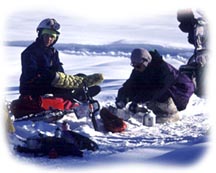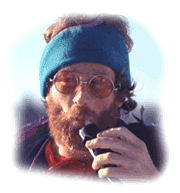Required Gear
 2 quart insulated water container
2 quart insulated water container- Headlamp or flashlight
- Rear flashing light
The three items listed above are all that are required for 50K racers. However, personal safety and comfort suggest you probably will choose to take additional gear. Water will be available at the half-way water stop. Racers are responsible for their own food.
Insulated Water Containers
The rule requires that you have at least a two-quart (64 ounce) capacity. If you dress properly and avoid sweating, this should be enough to get you between checkpoints. A special note to runners and snowshoers: you will be constantly cycling between hydration and dehydration and you must be disciplined about re-hydrating at checkpoints. It is advisable to carry an extra quart bottle (start with it empty) just in case you figure out that you are not keeping up.
 Outdoor Research (OR) makes nice bottle jackets. If it's a cold year (or you are broke), you can make your own out of a sheet of one-inch foam rubber and some duct tape. The plastic bladder (Camelbak, Platypus, or other name brands) is overwhelmingly the weapon of choice. Most competitors are well-informed as to their virtues. Bladders, however, aren't trouble free. Racers must be alert to the tendency of hoses to freeze, especially during the longer periods between checkpoints with which runners and snowshoers must contend.
Outdoor Research (OR) makes nice bottle jackets. If it's a cold year (or you are broke), you can make your own out of a sheet of one-inch foam rubber and some duct tape. The plastic bladder (Camelbak, Platypus, or other name brands) is overwhelmingly the weapon of choice. Most competitors are well-informed as to their virtues. Bladders, however, aren't trouble free. Racers must be alert to the tendency of hoses to freeze, especially during the longer periods between checkpoints with which runners and snowshoers must contend.
Try any or all of the following:
Once a racer got second-degree burns on a good portion of his back when his bladder was filled with near-boiling water. He was a mile or two out of the checkpoint, with the bladder buried under layers of clothing, before he realized he was about to become a soft-boiled egg. Think about the outside temperature and the body heat you're generating when you fill those bladders. They can provide a welcome heating pad during a cold stretch or they can turn your clothing into a steam room and sweat you to dehydration.
Bladders can and will leak or siphon their contents everywhere but where the fluid needs to go: into your mouth. Avoid these problems by selecting a dependable valve and then gluing or taping it onto the tube. As with all of your equipment, work with your drinking system, under winter conditions if possible, before the race to find and cure its weak points.
 Outdoor Research (OR) makes nice bottle jackets. If it's a cold year (or you are broke), you can make your own out of a sheet of one-inch foam rubber and some duct tape. The plastic bladder (Camelbak, Platypus, or other name brands) is overwhelmingly the weapon of choice. Most competitors are well-informed as to their virtues. Bladders, however, aren't trouble free. Racers must be alert to the tendency of hoses to freeze, especially during the longer periods between checkpoints with which runners and snowshoers must contend.
Outdoor Research (OR) makes nice bottle jackets. If it's a cold year (or you are broke), you can make your own out of a sheet of one-inch foam rubber and some duct tape. The plastic bladder (Camelbak, Platypus, or other name brands) is overwhelmingly the weapon of choice. Most competitors are well-informed as to their virtues. Bladders, however, aren't trouble free. Racers must be alert to the tendency of hoses to freeze, especially during the longer periods between checkpoints with which runners and snowshoers must contend.Try any or all of the following:
- Wrap the drinking tube with adhesive-backed pipe insulation, available at most plumbing and hardware stores;
- Run as much of the tube as possible under your clothes and use body heat to maintain a working temperature;
- Clear the tube after drinking by either blowing back into the tube or raising it while pinching the tip.
Once a racer got second-degree burns on a good portion of his back when his bladder was filled with near-boiling water. He was a mile or two out of the checkpoint, with the bladder buried under layers of clothing, before he realized he was about to become a soft-boiled egg. Think about the outside temperature and the body heat you're generating when you fill those bladders. They can provide a welcome heating pad during a cold stretch or they can turn your clothing into a steam room and sweat you to dehydration.
Bladders can and will leak or siphon their contents everywhere but where the fluid needs to go: into your mouth. Avoid these problems by selecting a dependable valve and then gluing or taping it onto the tube. As with all of your equipment, work with your drinking system, under winter conditions if possible, before the race to find and cure its weak points.
Headlamp or Flashlight
Virtually any device you bring to the check-in will be in compliance. Before selecting your light, consider the following rather contradictory factors:
- Winter nights in Alaska do not typically have the same intense darkness you encounter in warm climates where there is rarely any snow. Snow is highly reflective and can achieve great definition with even a small amount of light. However, because some sections offer technical riding on the course, avoid the temptation to cut corners with your lighting system.
- The wilderness through which the Susitna 100 is run is criss-crossed with a number of winter trails. The race course intersects many of these trails, some of which have proven quite alluring. The course is well-marked with reflective tape posted on trees and wooden stakes, a long, wide beam of light will catch these markers day or night. Bring extra batteries with you.
Rear Flashing Light
For traveling at night or camping, a small flashing light will alert snowmachines and other people on the trail as to your presence. If you camp for the night, hang the light from a nearby tree, a ski pole, or your bike, so roving race officials can take note of your location.
